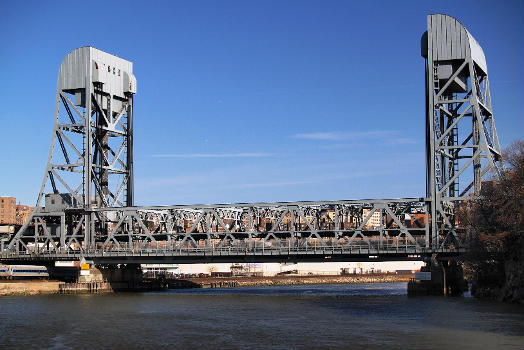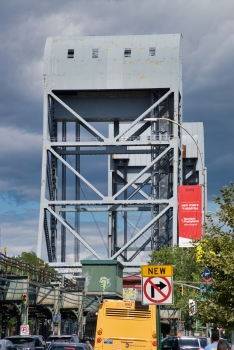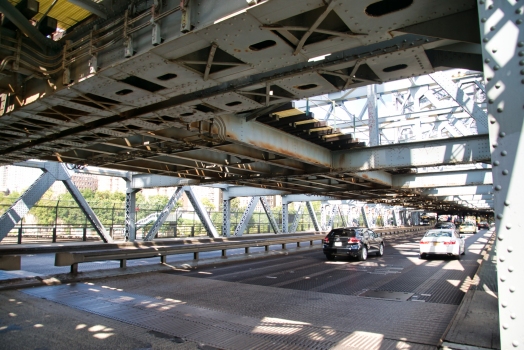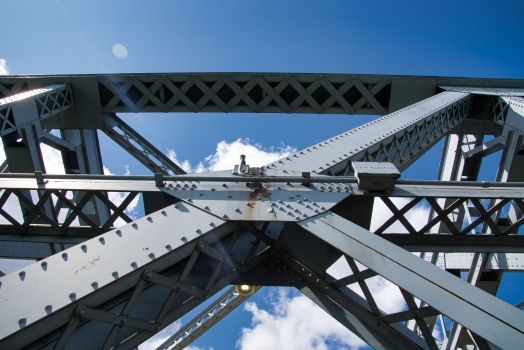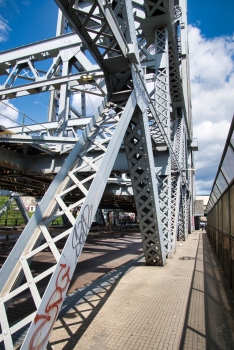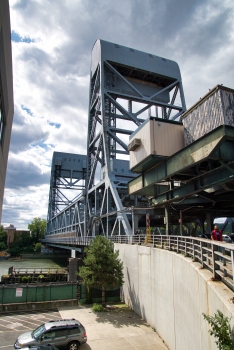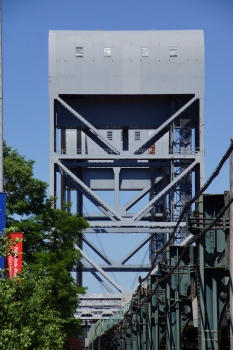General Information
Project Type
| Structure: |
Vertical lift bridge |
|---|---|
| Material: |
Steel bridge |
| Support conditions: |
for registered users |
| Material: |
Structurae Plus/Pro - Subscribe Now! |
| Secondary structure(s): |
Structurae Plus/Pro - Subscribe Now! |
| Function / usage: |
upper deck: Tramway, light or metro rail bridge lower deck: Road bridge |
Location
| Location: |
Manhattan, New York, New York, USA The Bronx, New York, New York, USA |
|---|---|
| Crosses: |
|
| Coordinates: | 40° 52' 24.96" N 73° 54' 39.96" W |
Technical Information
Dimensions
| main span | ca. 93 m | |
| total length | 170 m | |
| lower deck | number of lanes | 6 |
| pylons | number | 2 |
| upper deck | number of tracks | 3 |
Materials
| deck |
steel
|
|---|---|
| towers |
steel
|
Chronology
| 1 April 1959 | Construction started |
|---|---|
| 26 December 1960 | Opened to traffic |
Excerpt from Wikipedia
The Broadway Bridge is a lift bridge across the Harlem River Ship Canal in the borough of Manhattan in New York City. It connects the neighborhoods of Inwood on Manhattan island and Marble Hill on the mainland. The bridge is named because it carries Broadway, which is also designated as US 9 at this location. The bridge carries the New York City Subway's IRT Broadway–Seventh Avenue Line (1 train) above the road.
History
Before the Harlem River was rerouted, Marble Hill was part of Manhattan island. The bridge in the area was named Kings Bridge, crossing the river on the border between Marble Hill and the Bronx. The Boston Post Road and Albany Post Road crossed this bridge. A later bridge, opened on January 1, 1895, spanned the canal. A total of three bridges spanned the canal at this location. The 1895 bridge, a steam-powered swinging bridge, accommodated only highway and pedestrian traffic. It was replaced in 1905 by a bridge that could accommodate for the extension of the IRT subway line into the Bronx. The 1905 Broadway Bridge was also a swinging bridge, but a second deck was added to allow for subway traffic on the upper deck, and pedestrian and highway traffic on the lower deck. The 1905 iteration of the Broadway Bridge, that was being replaced by a new double-level structure, was reused to create the University Heights Bridge. In June 1906, the old bridge was floated down the river and placed on a newly constructed center pier. After all the approaches and other construction were completed, the new University Heights Bridge opened to traffic on January 8, 1908.
The present Broadway Bridge (opened on July 1, 1962) has a navigable channel 304 feet (93 m) wide providing 136 feet (41 m) of vertical clearance when the bridge is in the open position. In the down position, the bridge provides 24 feet (7.3 m) of vertical clearance.
Traffic
In 2010, the New York City Department of Transportation, which operates and maintains the bridge, reported an average daily traffic volume in both directions of 37,292. The peak ADT over the Broadway Bridge was 42,555 vehicles in 1990.
Public transportation
The Broadway Bridge carries the New York City Subway's 1 train. As such, when the bridge is open, 1 trains terminate at 215th Street. Shuttle buses provide service to Van Cortlandt Park-242nd Street. Immediately to the north of the bridge along this line is the Marble Hill–225th Street station.
The bridge also carries the Bx7 and Bx20 local bus routes operated by MTA New York City Transit, and the BxM1 express bus route operated by the MTA Bus Company.
Text imported from Wikipedia article "Broadway Bridge (Manhattan)" and modified on July 22, 2019 according to the CC-BY-SA 4.0 International license.
Participants
Relevant Web Sites
Relevant Publications
- (2002): PT on Broadway Bridge. In: News. The VSL-Intrafor Magazine, v. 13, n. 1 ( 2002), pp. 14.
- About this
data sheet - Structure-ID
20001735 - Published on:
12/08/2001 - Last updated on:
12/07/2024

